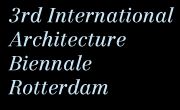Counterforces
The Visionary Power exhibition presents the material results of an inquiry into the forces that affect the development of our cities worldwide; into the effects these forces have on our everyday surroundings; and into the capacities of a young generation of architects to cope with and possibly manipulate such forces.
Research
Last summer the curators of this Biennale asked five international teams of theorists and architects to reduce their knowledge of the forces that affect cities – like migration, fear, commerce, tourism and representation – to a well-defined problem: an urgent question about the possible future of the city.
The Biennale subsequently asked young and talented architects from all over the world to comment on the propositions that were put forward. They were given a threefold assignment: ‘select an urban force that matches your own projects and research; indicate a city in which this force is strikingly manifest; and create an architectural strategy to deal with this phenomenon.’ Out of close to 100 responses, the curators chose the 14 cities and teams of architects that are now part of the Visionary Power project.
Projects for the City
Over the past six months, in Mexico, Austria, South Africa, Lebanon, China and other countries, the selected architects worked on their ‘projects for the city’, which are now on show in the Rotterdam Kunsthal and which express their commitment to the future of our cities. They ask how, in 2050, the then nearly 6 billion city dwellers will be able to live and survive together in mushrooming megacities; how policymakers, companies and inhabitants will manage to steer global forces in the right direction locally; and, especially, how they, the architects themselves, will succeed in bearing a visionary and directive part once again.
Once again: for visionary plans are out of fashion, and society has turned out not to be ‘makeable’. So are we going to wash our hands of the city of the future? Expose it to the forces that affect it so insolently? The Visionary Power scientists and architects don’t think so. Their analyses and strategies are counter-forces: modest yet ambitious attempts to make cities more sustainable, comfortable and beautiful in the future.
Busan, South Korea
Thanks to the rapid evolution of ecological technologies, Inaba (Los Angeles) predicts a radical change in the way we will build our offices and cities. Busan will become the pioneer for the new ecological city.
Luoyang, China
Yimin Zhu (Guangzhou) refuses to let the urban expansion in Luoyang be dictated by the standard vision of economic success. The historic structure of the Chinese city forms the premise for an alternative project, which is a rejection of the current spectacle architecture of China’s cities.
New Jersey, USA
Segal & Verbakel (Princeton University) offer a toolbox to transform the chaotic landscape of the most densely populated state in the USA, filled with fragmented industrial estates, into a modern-day ‘city-state’.
Spectacle Cities / John Urry
Rome, Italy
Baukuh (Genoa) infuses new life into the city by opening Rome’s archaeological patrimony to contemporary use by the city’s tourists and residents.
Havana, Cuba
To ease the pressure the tourists are placing on the historic city centre, a-u-r-a (Ulm) + FünDC (Rotterdam) has designed an artificial island and leisure facilities in Havana Bay.
Innsbruck, Austria
Accreditation as a UNESCO World Heritage Site threatened to paralyze Innsbruck, so the city withdrew its candidacy. Bad_architects (Innsbruck) has developed criteria to assess contemporary architecture in heritage sites.
Capital Cities / Pier Vittorio Aureli and Martino Tattara
Astana, Kazakhstan
When Astana was designated Kazakhstan’s new capital, a new city emerged out of nothing, composed of governmental buildings in a monumental emptiness. As a counterbalance, Inter.National.Design (Rotterdam) turns the old communist centre into a public place for all Kazakhs.
Beirut, Lebanon
In a series of subversive scenarios, WORK Architecture Company (New York) turns the touristy historic centre of Beirut once more into the symbolic heart of Lebanon, in which the country’s various ethnic and religious groups can find a place.
Moscow, Russia
Alexander Sverdlov (Rotterdam/Moscow) has designed 400 identical residential towers that reinforce the endless fields of prefabricated blocks of flats on the fringes of the city, giving present-day Moscow a powerful face.
Informal Cities / Alfredo Brillembourg and Hubert Klumpner
São Paulo, Brazil
MMBB Arquitectos (São Paolo) proposes developing the giant water reservoirs being constructed all over the city as flood defences into public spaces for the informal city.
Mexico City, Mexico
In three great urban expansion zones in Mexico City, Arquitectura 911sc (Mexico City) goes in search of a way in which formal and informal architecture can complement each other.
Tijuana, Mexico/San Diego, USA
A wall of concrete and barbed wire between the USA and Mexico forms the backdrop for the small-scale architecture through which Estudio Teddy Cruz (San Diego) destabilizes the discriminatory spatial planning of the American city.
Hidden Cities / Lieven de Cauter and Michiel Dehaene
Ceuta, Spain
Office Kersten Geers David Van Severen (Brussels) give the border crossing in Ceuta, a Spanish enclave on Moroccan soil, a concrete face: a city of refugees in the no-man’s-land between two worlds.
Johannesburg, South Africa
The Johannesburg of 2007 is still ruled by apartheid. A public housing project by blacklinesonwhitepaper (Johannesburg) aims to turn the tide in the old business district, situated between an enclave for the rich and a former township.
Publication
There will be a publication with this exhibition. For more information about this book go to:


